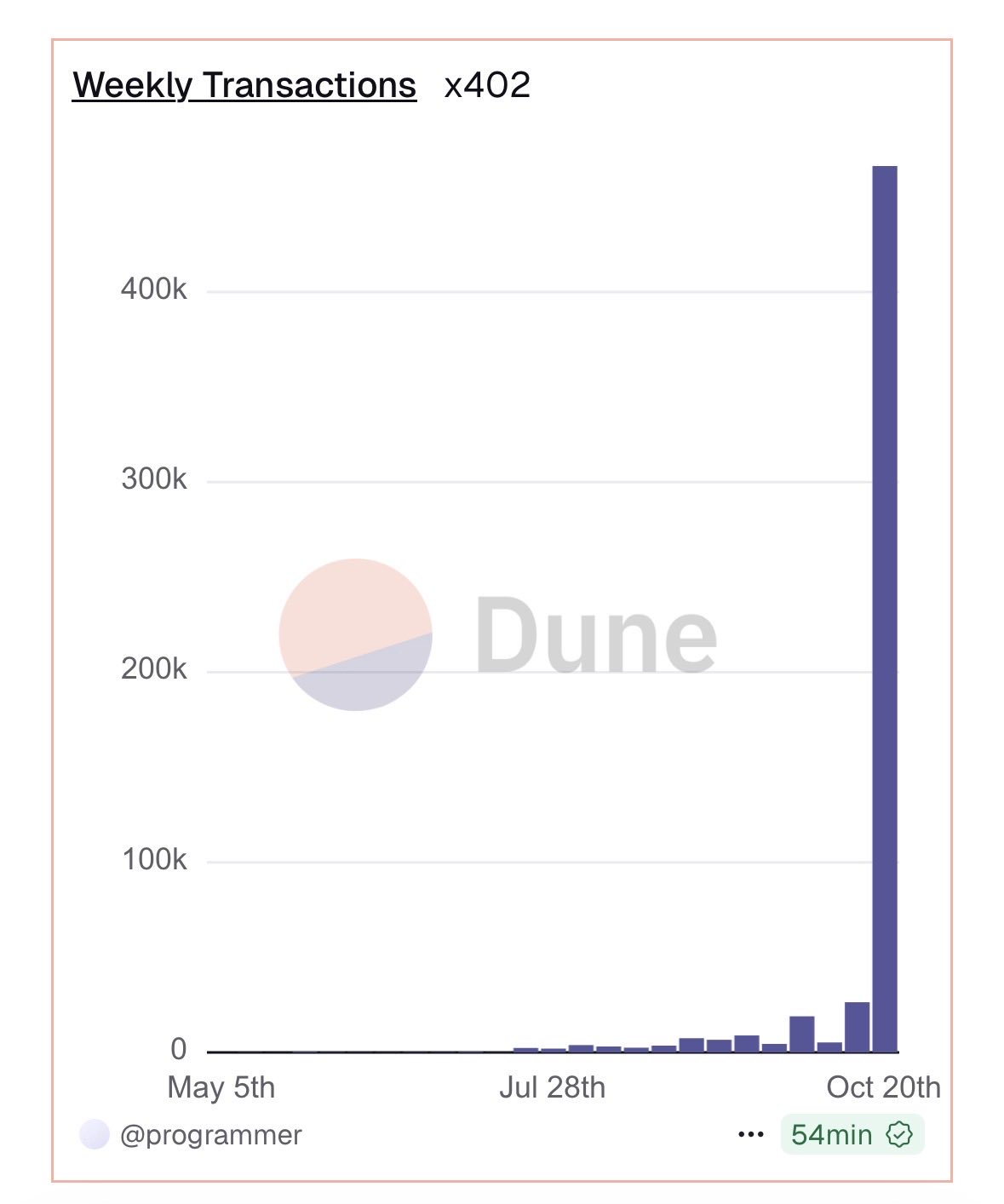
Are Moonshots Only Meme Coins?
%201.svg)
%201.svg)


Introduction: The Meme Coin Myth
When most people think “moonshot” in crypto, they think of meme coins like Dogecoin, Shiba Inu, or Pepe — volatile, viral, and often with no utility. While it’s true that meme coins have historically delivered explosive returns, they’re just one type of moonshot. In reality, some of the best moonshots are deeply technical projects with innovative real-world use cases.
In this blog, we’ll explore why moonshots go far beyond memes, the other types of high-potential assets you should be watching, and how to distinguish hype from substance in your moonshot hunt.
Why Meme Coins Became the Face of Moonshots
Meme coins dominate headlines and retail attention for good reason:
- Low entry barriers – Often priced at fractions of a cent
- Viral marketing – Driven by memes, humor, and community hype
- Explosive gains – SHIB, DOGE, and PEPE all had 1,000x+ runs
- Community-driven – Holders often act as evangelists
Because of these qualities, meme coins are often perceived as the only moonshots. But perception doesn’t equal reality.
The Reality: Many Moonshots Are Utility-Driven
Some of the most successful moonshot investments didn’t begin as memes — they were innovative, under-the-radar projects that grew into billion-dollar ecosystems:

None of these were memes — they were tech-focused moonshots.
Categories of Non-Meme Moonshots
Here are several non-meme sectors producing moonshot-level gains:
- AI Coins – e.g., Fetch.ai, Render, Akash
- DePIN (Decentralized Physical Infrastructure) – e.g., Helium, IoTeX
- RWAs (Real-World Assets) – e.g., Centrifuge, Goldfinch
- L2 & Interoperability – e.g., Starknet, Hyperlane, Axelar
- Privacy Coins – e.g., Namada, Secret Network
- Early-stage L1s – e.g., SEI, Monad
These projects combine visionary ideas with real-world applicability — and many began as stealth moonshots before going mainstream.
How to Spot Utility-Based Moonshots Early
Look for:
- Unique narrative fit – Aligns with hot macro themes (AI, DeFi 2.0, Web3 infra)
- Underexposed – Not yet listed on major CEXs or hyped by influencers
- Backed by smart money – VC involvement or known crypto angels
- Product roadmap – Testnet/Mainnet imminent or newly launched
- Active GitHub or whitepaper – Real builders, not marketers
Meme coins may be powered by emotion — but utility moonshots are powered by execution.
Token Metrics Helps Spot Both Meme & Utility Moonshots
Token Metrics doesn’t just chase hype — it grades thousands of tokens using 80+ data points including:
- Momentum and price trends
- Community sentiment and buzz
- GitHub commits and developer activity
- Market cap ranking
- AI-generated bull/bear signals
- Smart contract risk analysis
This means you can discover both emerging meme coins and tech-driven moonshots based on real metrics — not just Twitter noise.
Can Meme Coins Still Be Valid Moonshots?
Yes — but they should be treated like short-term plays with proper risk management. When timed right (early launch, CEX rumor, meme trend), meme coins can 10x fast. But unlike utility tokens, meme coins often lack long-term sustainability unless they evolve (like DogeX or SHIB ecosystem).
Use tools like Token Metrics AI Signals to time entries and exits.
⚠️ Avoiding the Meme Coin Traps

Don’t confuse “meme” with “momentum.” Use data.
Conclusion: The Smart Moonshot Portfolio is Diversified
If your moonshot portfolio is 100% meme coins, you're gambling. If it’s 100% early L1s with no traction, you may be stuck waiting years. Smart investors build a balanced basket that includes:
- Memes with momentum
- Mid-cap undervalued alts
- Undiscovered AI, RWA, and DePIN gems
- Fundamental plays with strong tokenomics
Meme coins are just one path to the moon — don’t miss the others.
AI Agents in Minutes, Not Months


.svg)



Create Your Free Token Metrics Account





.png)
Recent Posts
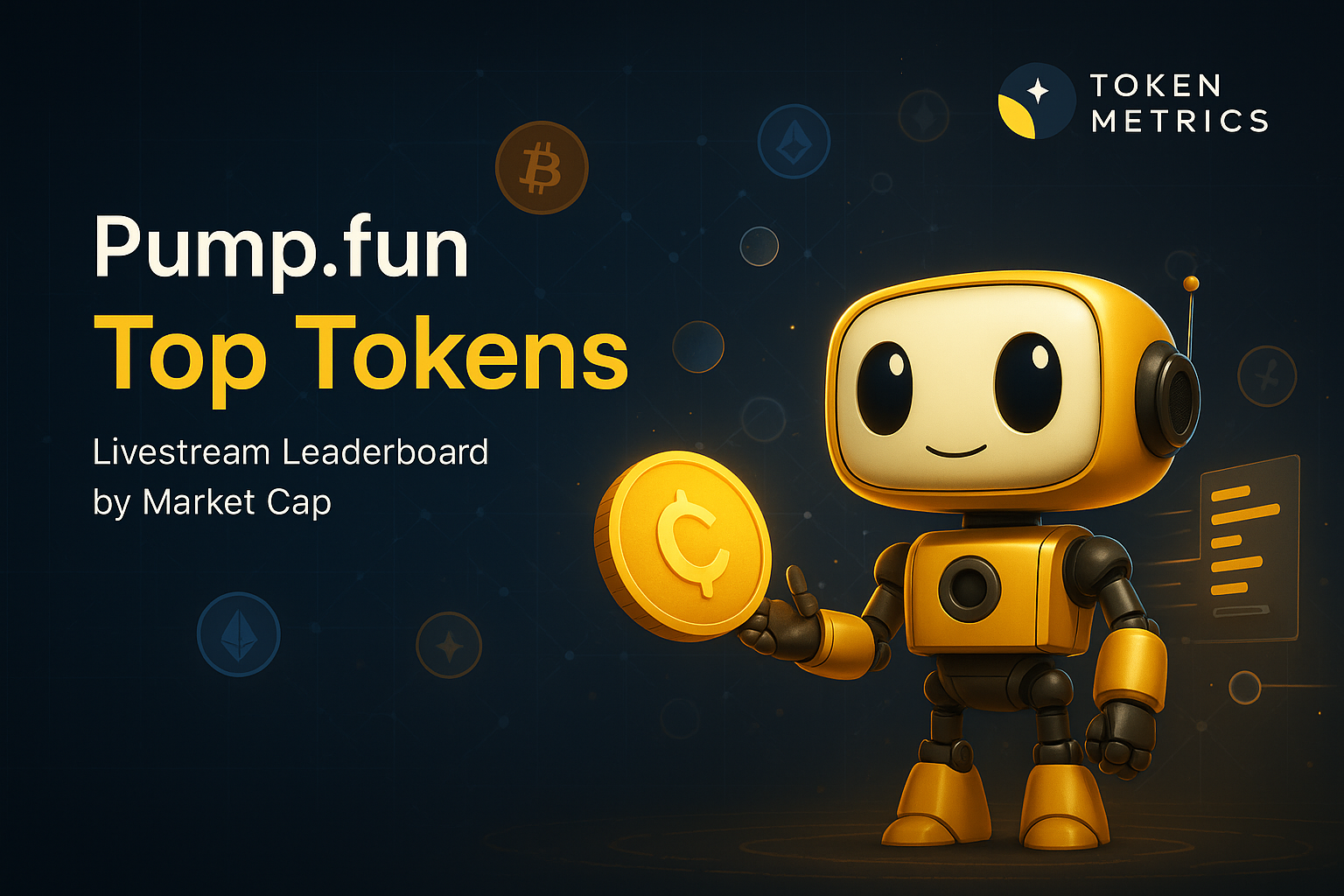
Top 10 Pump.fun Livestream Tokens by Market Cap
%201.svg)
%201.svg)
Market Cap Rankings for Pump.fun Livestream Tokens
Market Cap represents the circulating valuation of a token. For livestream tokens on Pump.fun, market cap provides a fast way to compare where capital has concentrated, and which communities have built sustained traction. This post references pump.fun crypto context where relevant.
This ranking selects the top 10 Pump.fun tokens by Market Cap from the provided screenshots. Numbers, tickers, and dates are kept exactly as shown, and any missing datapoints are marked with a dash.
Methodology and Secondary Signals
Market cap is a snapshot of attention and liquidity at a point in time. We also track engagement rate and seven-day retention as complementary signals of durability.
When market cap pairs with strong engagement and retention, Pump.fun projects tend to sustain momentum longer. For discovery, some readers follow pump.fun trending tokens and pump.fun new token launches to compare momentum.
Token Metrics Live (TMLIVE): Research-Backed Analysis Enters Pump.fun
While most Pump.fun livestream tokens center on memes, gaming, or creator personalities, Token Metrics Live (TMLIVE) brings a different approach, research-driven market analysis backed by 7 years of consistent crypto content and a 500K+ audience.
TMLIVE launched on Pump.fun on November 4, 2024, capturing 876 holders in its first 22 hours. The token reached an ATH market cap of $291.7K with $1.7M in 24-hour volume, demonstrating strong initial adoption from both the existing Token Metrics community of 100,000+ platform users and new Pump.fun participants.
The team behind TMLIVE has a proven track record in identifying market opportunities early, including coverage of MATIC and Helium in 2018, both became significant market winners. This credibility factor differentiates TMLIVE from hype-driven tokens, positioning it as a substance-over-speculation play in the Pump.fun livestream space.
This blog ranks the top 10 Pump.fun livestream tokens by holder count, examining how community distribution patterns reveal different engagement strategies and durability signals across the ecosystem.
TLDR: Top Pump.fun Token Highlights
- GeorgePlaysClashRoyale leads by a wide margin at $45.2M MC, followed by Codec Flow at $17.1M.
- Mid-tier projects like Tokabu, Chill House, VampCatCoin, and PUMPCade cluster in the $5 to $7M range.
- New XAI gork shows strong 24H momentum (+41.33 percent) despite a smaller $1.6M MC.
- DraperTV posts the largest 24H move among mid-caps at +93.83 percent.
- Token Metrics Live is new with $49.5K MC and early holder growth. For context on valuation, readers often check pump.fun token price or pump.fun price on public pages before comparing caps.
Leaderboard: Pump.fun Tokens by Market Cap
Note, data is taken from screenshots at the time of capture. Reference signals like pump.fun trending tokens 24h gain holders volume for additional context.
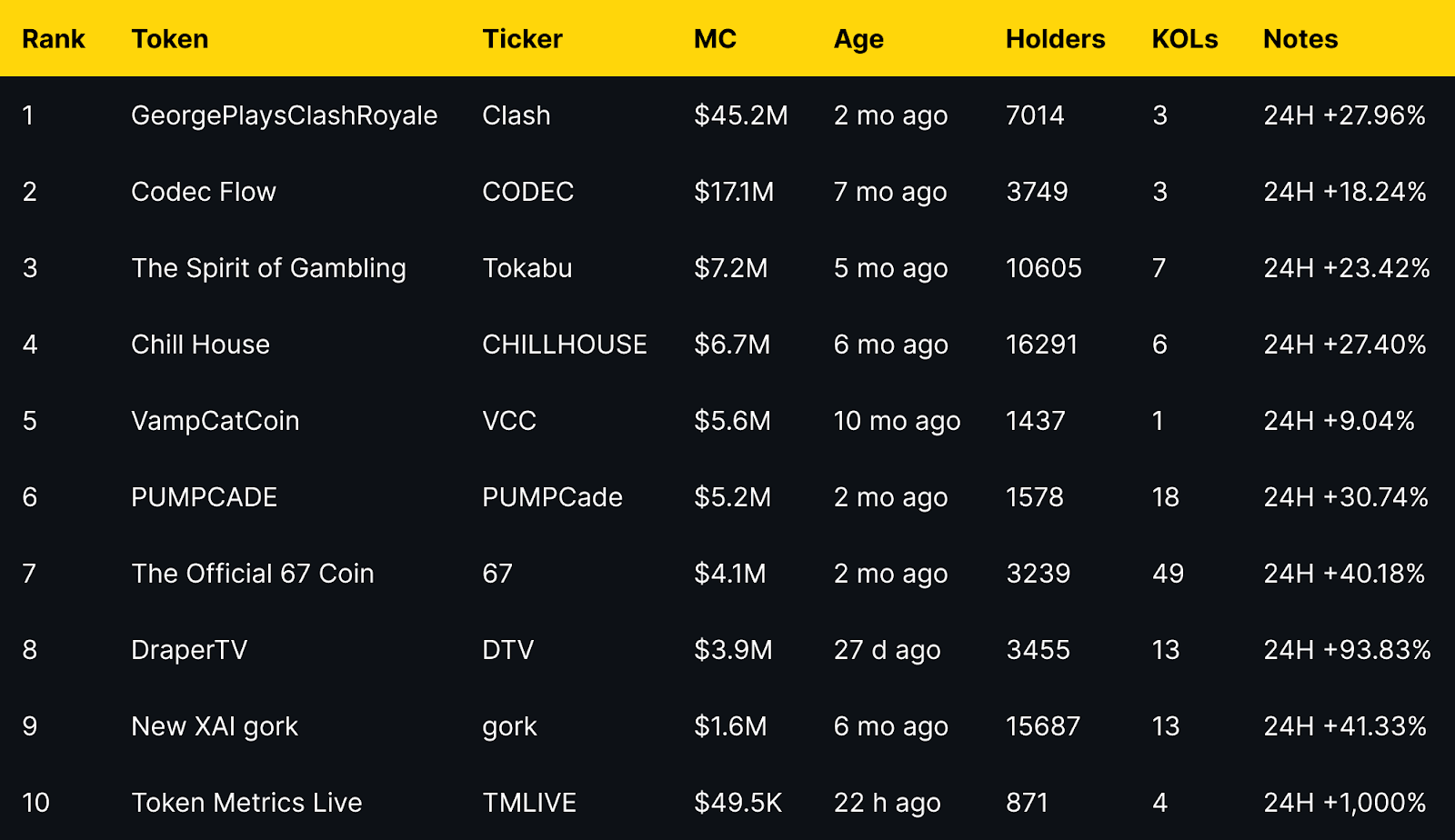
Benchmarks to Watch for Pump.fun Livestream Success
- Peak concurrent viewers
- Average watch time
- Chat messages per minute
- Follower conversion rate from viewers
- Seven day retention versus launch day
Use these to compare Pump.fun projects beyond market cap. If a data point is not visible in public screenshots, mark it with a dash in the table.
The distribution shows a clear long tail. One mega cap leader, one strong upper mid cap, then a cluster between $3.9M and $7.2M. Several mid caps display notable 24H moves, suggesting active communities and recent stream driven interest.
What Each Pump.fun Livestream Token Does
GeorgePlaysClashRoyale (Clash): Creator Gaming Stream
Watch George play the game Clash Royale on Pump.fun livestreams. Community interest is driven by creator led live content and regular gameplay moments that translate to token engagement. As a pump.fun coin on Solana, the appeal is creator first.
Quick facts: chain = Solana, status = live, milestone = ATH $87.9M shown

https://pump.fun/coin/6nR8wBnfsmXfcdDr1hovJKjvFQxNSidN6XFyfAFZpump
Codec Flow (CODEC): Infrastructure for AI Agents
On demand cloud desktops infrastructure for AI agents. The Codec Flow narrative centers on AI tooling and always on compute for agents using streamed engagement.
Quick facts: chain = Solana, status = live, milestone = ATH $47.2M shown
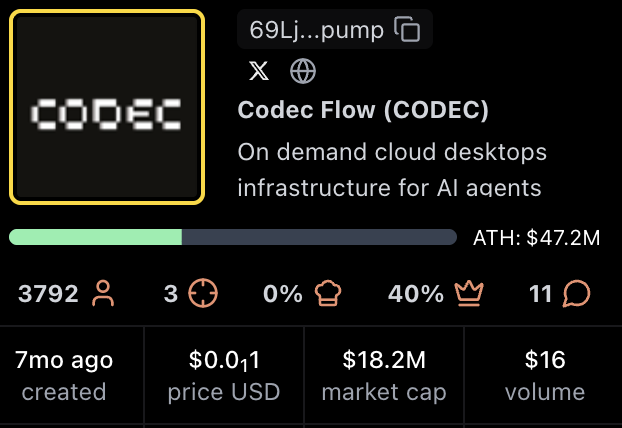
https://pump.fun/coin/69LjZUUzxj3Cb3Fxeo1X4QpYEQTboApkhXTysPpbpump
The Spirit of Gambling (Tokabu): Meme Character with Gambling Motif
"I am Tokabu, the spirit of gambling." The Tokabu project leans into a playful narrative and steady Pump.fun live presence.
Quick facts: chain = Solana, status = live, milestone = ATH $78.1M shown

https://pump.fun/coin/H8xQ6poBjB9DTPMDTKWzWPrnxu4bDEhybxiouF8Ppump
Chill House (CHILLHOUSE): Community Meme with Cozy Theme
"Just a chill house." The Chill House theme suggests community vibes and frequent participation during Pump.fun streams.
Quick facts: chain = Solana, status = live, milestone = ATH $31.6M shown
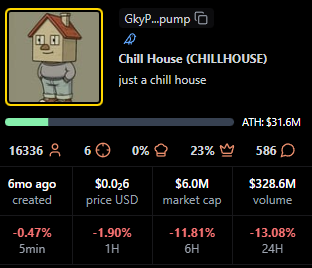
https://pump.fun/coin/GkyPYa7NnCFbduLknCfBfP7p8564X1VZhwZYJ6CZpump
VampCatCoin (VCC): Cute Vampire Cat Meme
Cats and campy vampire aesthetics drive the VampCatCoin meme. Community humor and recurring references keep engagement high during Pump.fun streams.
Quick facts: chain = Solana, status = live, milestone = ATH $7.4M shown
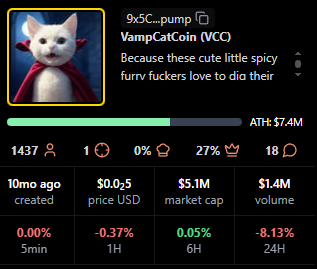
https://pump.fun/coin/9x5CLPb3SeYSBKvautqpJWPjX9TUCVcWTS12Xawapump
PUMPCADE (PUMPCade): Arcade Mini Games Inside Live Chat
"Play arcade games with others in a Pump.fun live chat and win." The hook is interactive gameplay blended with streaming.
Quick facts: chain = Solana, status = live, milestone = ATH $9.3M shown

https://pump.fun/coin/Eg2ymQ2aQqjMcibnmTt8erC6Tvk9PVpJZCxvVPJz2agu
The Official 67 Coin (67): Creator and Fan Coin
The 67 Coin meme centers on a creator identity and fan-driven momentum on Pump.fun.
Quick facts: chain = Solana, status = live, milestone = ATH $8.0M shown
https://pump.fun/coin/9AvytnUKsLxPxFHFqS6VLxaxt5p6BhYNr53SD2Chpump
DraperTV (DTV): Media and Community Token
"Welcome to Draper TV, a pioneering hub for startup innovation." The DraperTV token sits at the intersection of media, startups, and community engagement during Pump.fun streams.
Quick facts: chain = Solana, status = live, milestone = ATH $21.5M shown
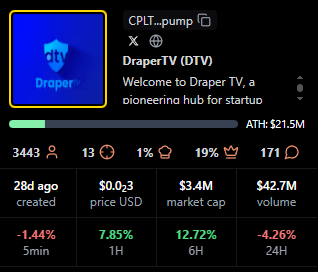
https://pump.fun/coin/CPLTbYbtDMKZtHBaPqdDmHjxNwESCEB14gm6VuoDpump
New XAI gork (gork): Minimal Meme
No description available. Project details unclear at time of writing.
Quick facts: chain = Solana, status = live, milestone = ATH $100.9M shown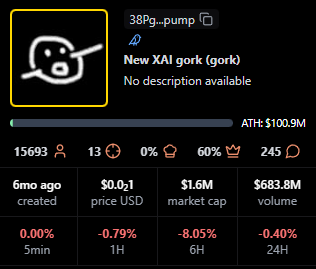
https://pump.fun/coin/38PgzpJYu2HkiYvV8qePFakB8tuobPdGm2FFEn7Dpump
Token Metrics Live (TMLIVE): Media and Live Coverage Token
Token Metrics Live: real-time, data-driven crypto analysis with token breakdowns and live Q&A. 7 years streaming, 500K+ audience. We turn on-chain signals into strategy, actionable insights, smart tools, and a learning community.. TMLIVE powers Token Metrics live coverage and community streams on Pump.fun.
Authority and substance tend to win on Pump.fun. Consistent analyst-led segments, live screening, and real Q and A-drive engagement that lasts beyond a single meme spike.
Quick facts: chain = Solana, status = Created 22 h ago, milestone = ATH $291.7K shown
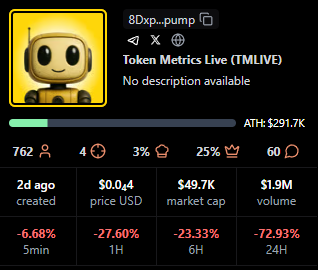
https://pump.fun/coin/8Dxpc8Q8jg7TK8TT1pVntcqunHGofqpetCaP5fEhpump
Signals From Market Cap Performance
- Higher Market Cap tends to coincide with creator led narratives and sustained streaming cadence on Pump.fun. Several tokens in the $5 to $7M range show steady 24H gains, suggesting ongoing participation rather than one off spikes.
- Smaller caps with large percentage moves (for example gork and DTV) indicate where attention may be rotating intra day.
- Market Cap alone does not imply durability, so pairing this view with holders, viewers, and fees is essential. Some readers also track pump.fun solana new tokens feeds for rotation clues.
Additional Signals to Watch for Pump.fun Token Success
- Structured segments and interactive formats increase average watch time and chat velocity, which correlate with healthier communities after launch.
- Clear expectations and transparent messaging improve seven day retention compared with hype only streams.
- Multi channel amplification across X, Telegram, Discord, and email consistently lifts day one reach and discovery for Pump.fun tokens.
Why This Matters for Creators and Traders
- Creators can design Pump.fun launches around consistent live segments and clear narratives. The leaders here demonstrate how personality, interactivity, or utility themes can carry Market Cap beyond a single hype window.
- Traders can use Market Cap to quickly size a Pump.fun token's current standing, then layer in Avg Viewers, holders, and fees to judge staying power and crowd quality.
Creator Playbook: Turn Market Cap into Staying Power
- Build a real audience first with four to eight weeks of consistent shows on Pump.fun.
- Run a structured show for forty five to sixty minutes with clear segments.
- Deliver value beyond price talk with analysis, frameworks, and tools viewers can reuse.
- Invest in stable audio and video, use on screen CTAs, and make it easy to follow or subscribe.
- Coordinate X, Telegram, Discord, and email pushes, then measure results in real time and adjust.
Watch Real Time Coverage on TV Live
- TV Live brings fast, reliable coverage of Pump.fun streams, token leaderboards, and community momentum. Catch live breakdowns, context on spikes, and interviews with creators.
- CTA: Watch TV Live for real time crypto market news → TV Live Link
- CTA: Follow and enable alerts → TV Live
- For pump.fun news today and real-time breakdowns, watch Token Metrics Live.
Use Token Metrics discovery tools, AI-powered data, and deep analyst research to compare Pump.fun tokens beyond price momentum. Tap into livestreamed daily crypto market intelligence, on-chain signals, and automated alerts to stay ahead of meme coin and Solana trend cycles. Join 100,000+ active users — try Token Metrics free.
FAQs About Pump.fun Livestream Token Market Caps
What non market cap signals matter most for Pump.fun token durability?
Engagement rate measured as messages per viewer per hour, average watch time, follower conversion from viewers, and seven day retention matter most for Pump.fun token durability. These show whether attention sticks once the stream ends.
What is the best way to track Pump.fun livestream leaders by Market Cap?
Use stalkchain.com/streams/scanner or Pump.fun token pages to view current market cap rankings. For historical context, save periodic screenshots to compare changes over time.
Does higher Market Cap predict higher future returns for Pump.fun tokens?
Higher Market Cap does not necessarily predict higher future returns. Market Cap reflects current valuation, not forward performance. Combine it with viewers, fees, and holder growth to evaluate momentum and resilience.
How often do Pump.fun token market cap rankings change?
Pump.fun token market cap rankings change intraday in many cases. This post reflects the timestamp of the provided screenshots.
what is pump.fun
Pump.fun is a Solana based launch and livestream platform where creators can launch tokens and stream to communities. It is a directory of coins and live shows with token pages, a feed, and basic discovery features.
how does pump.fun work
Creators launch a token and go live, viewers discover and watch streams, and token pages show public metrics. Always verify contract addresses on chain and avoid relying on unverified claims.
is pump.fun legit
Pump.fun is a widely used Solana site for token launches and streams. As with any crypto site, use caution, verify contracts, and never invest more than you can afford to lose.
how to make a coin on pump.fun / how to create a coin on pump.fun
On the pump.fun website, creators use the launch flow to create a token, provide basic details, and publish. Review the interface carefully and confirm on chain details before sharing links.
pump.fun program id solana / pump.fun solana program id / pump.fun program id
On Solana, a program ID identifies the deployed program that executes instructions. The program ID typically appears in developer tooling or Explorer views for the pump.fun contracts.
pump.fun api / pump.fun api docs / pump.fun api documentation
APIs let developers read public data like token lists or recent launches. Check official pump.fun documentation pages for endpoints and usage, then test carefully in a sandbox.
pump.fun bonding curve formula
A bonding curve describes how token price changes as supply increases. Many launch tools use curves that raise prices as more tokens are bought. This is educational only and not investment advice.
pump.fun airdrop
Airdrops are sometimes mentioned by communities. Treat any airdrop claims with caution and verify through official channels. There are no guarantees.
pump.fun price prediction
Price predictions are inherently uncertain and speculative. For education, compare public metrics and historical snapshots, and avoid relying on forecasts.
pump.fun coin / pump.fun token
These phrases generally refer to tokens launched on the site. Always verify token pages and on chain data.
pump.fun token price / pump.fun price / pump.fun pump price / pump.fun token pump price
Current price views are available on token pages. Prices change frequently during livestreams and may differ across aggregators.
pump.fun bot
Some users employ trading or alert bots to monitor launches and prices. Use third party tools with care and do not share private keys.
pump.fun revenue
Public pages sometimes describe fees and platform mechanics. Revenue models can include creator or platform fees documented on official resources.
teen pump.fun 250m khaliliwired / teen 50k pump.fun
These look like search phrases seen in community chatter. Treat unrelated viral terms with skepticism and rely on official project pages for facts.
pump.fun token bonding time raydium listing
Some launches discuss bonding or listing timelines. Check the specific token page or official posts for any Raydium listing details.
pump.fun logo
Logos typically appear on token or platform pages. Use official assets from the pump.fun website when available.
pump.fun website
Visit the main directory to explore streams, coin pages, and recent launches. Bookmark official links only.
Next Steps for Tracking Pump.fun Tokens
- Subscribe to TV Live updates → [NEWSLETTER_OR_ALERTS_LINK]
- Read the next leaderboard post in this series.
- Join the community stream on Pump.fun if a link is provided.
- Track viewer, chat, follow, and retention metrics for each token you monitor, then re rank your personal list every week.
Disclosure
Educational content only. Cryptocurrency involves risk. Always do your own research.
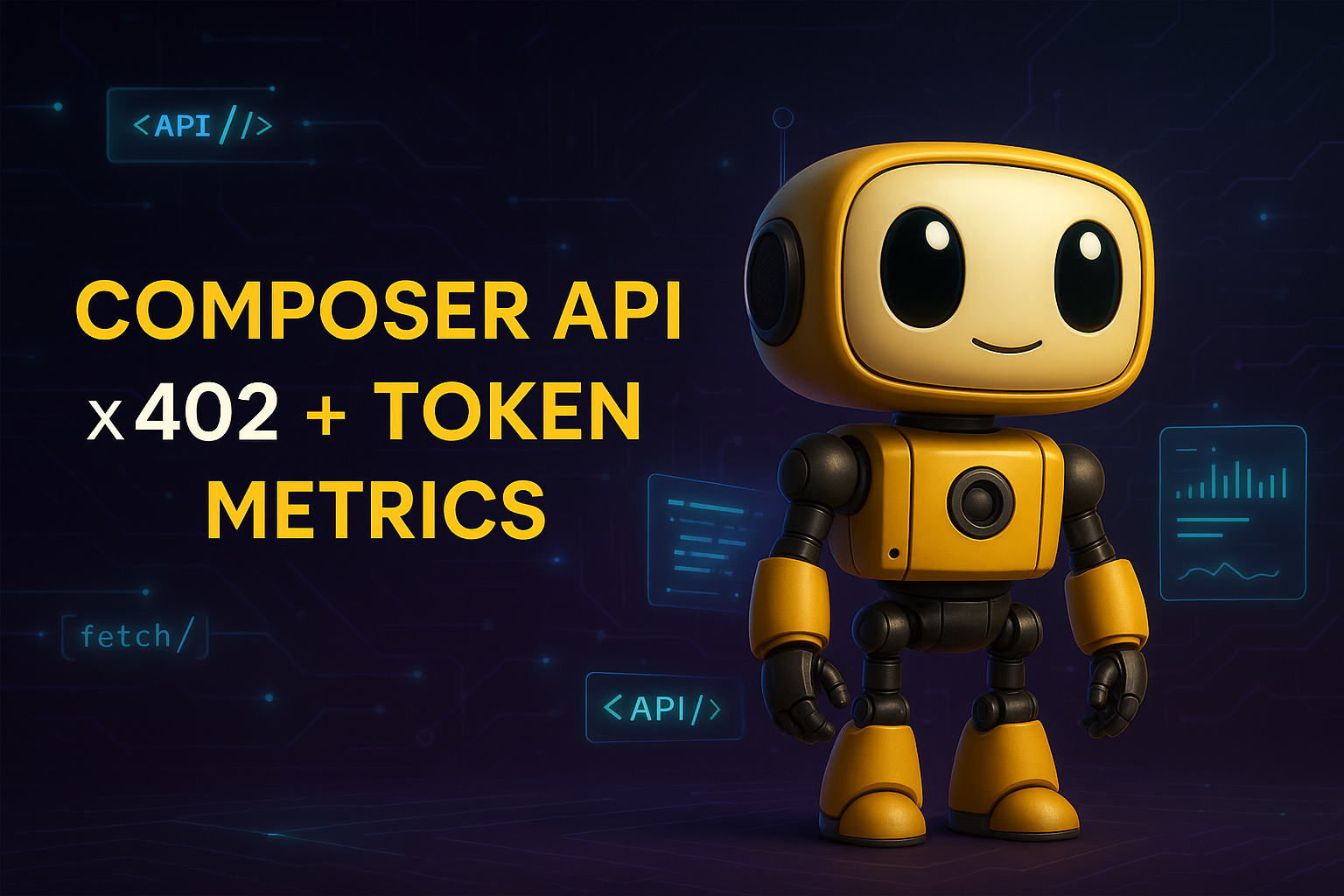
How to Use x402 with Token Metrics: Composer Walkthrough + Copy-Paste Axios/HTTPX Clients
%201.svg)
%201.svg)
What You Will Learn — Two-Paragraph Opener
This tutorial shows you how to use x402 with Token Metrics in two ways. First, we will walk through x402 Composer, where you can run Token Metrics agents, ask questions, and see pay-per-request tool calls stream into a live Feed with zero code. Second, we will give you copy-paste Axios and HTTPX clients that handle the full x402 flow (402 challenge, wallet payment, automatic retry) so you can integrate Token Metrics into your own apps.
Whether you are exploring x402 for the first time or building production agent workflows, this guide has you covered. By the end, you will understand how x402 payments work under the hood and have working code you can ship today. Let's start with the no-code option in Composer.
Start using Token Metrics X402 integration here. https://www.x402scan.com/server/244415a1-d172-4867-ac30-6af563fd4d25
Part 1: Try x402 + Token Metrics in Composer (No Code Required)
x402 Composer is a playground for AI agents that pay per tool call. You can test Token Metrics endpoints, see live payment settlements, and understand the x402 flow before writing any code.
What Is Composer?
Composer is x402scan's hosted environment for building and using AI agents that pay for external resources via x402. It provides a chat interface, an agent directory, and a real-time Feed showing every tool call and payment across the ecosystem. Token Metrics endpoints are available as tools that agents can call on demand.
Explore Composer: https://x402scan.com/composer
Step-by-Step Walkthrough
Follow these steps to run a Token Metrics query and watch the payment happen in real time.
- Open the Composer agents directory: Go to https://x402scan.com/composer/agents and browse available agents. Look for agents tagged with "Token Metrics" or "crypto analytics." Or check our our integration here. https://www.x402scan.com/server/244415a1-d172-4867-ac30-6af563fd4d25
- Select an agent: Click into an agent that uses Token Metrics endpoints (for example, a trading signals agent or market intelligence agent). You will see the agent's description, configured tools, and recent activity.
- Click "Use Agent": This opens a chat interface where you can run prompts against the agent's configured tools.
- Run a query: Type a question that requires calling a Token Metrics endpoint, for example "Give me the latest TM Grade for Ethereum" or "What are the top 5 moonshot tokens right now?" and hit send.
- Watch the Feed: As the agent processes your request, it will call the relevant Token Metrics endpoint. Open the Composer Feed (https://x402scan.com/composer/feed) in a new tab to see the tool call appear in real time with payment details (USDC or TMAI amount, timestamp, status).
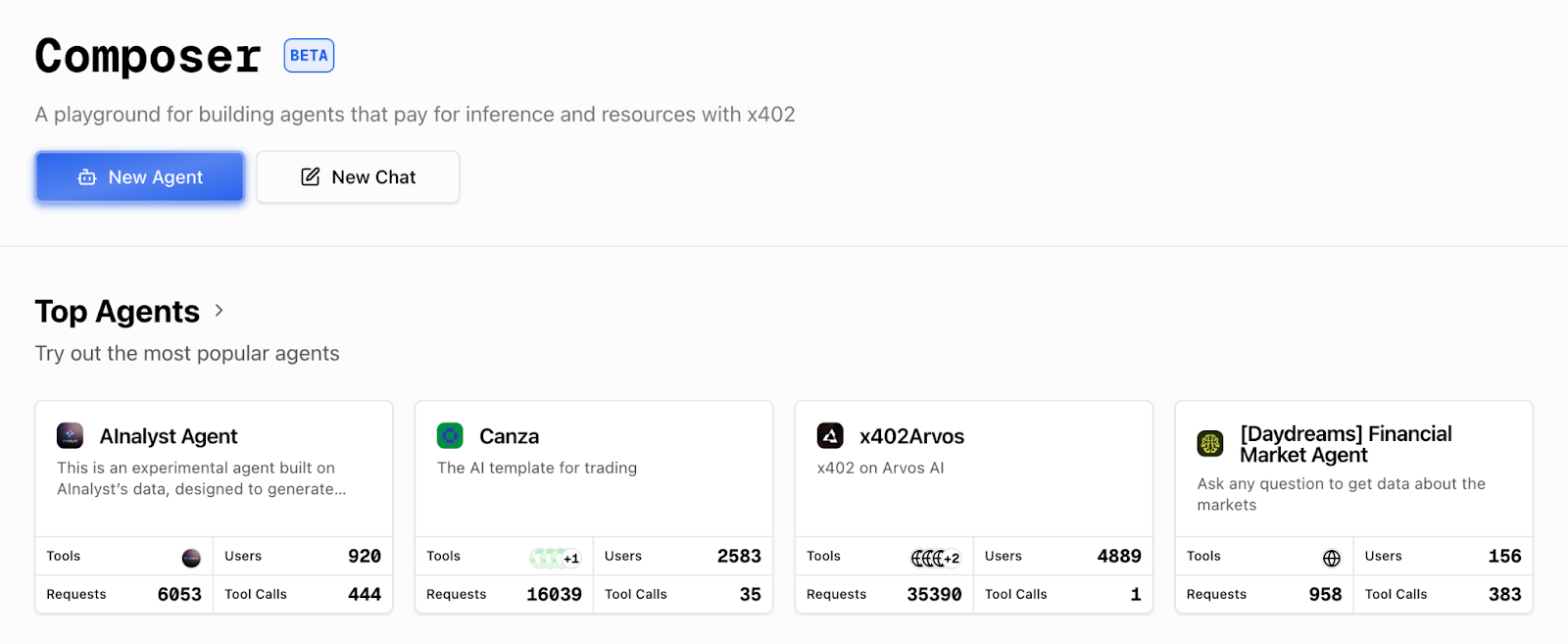
Composer agents directory: Composer Agents page: Each agent shows tool stack, messages, and recent activity.
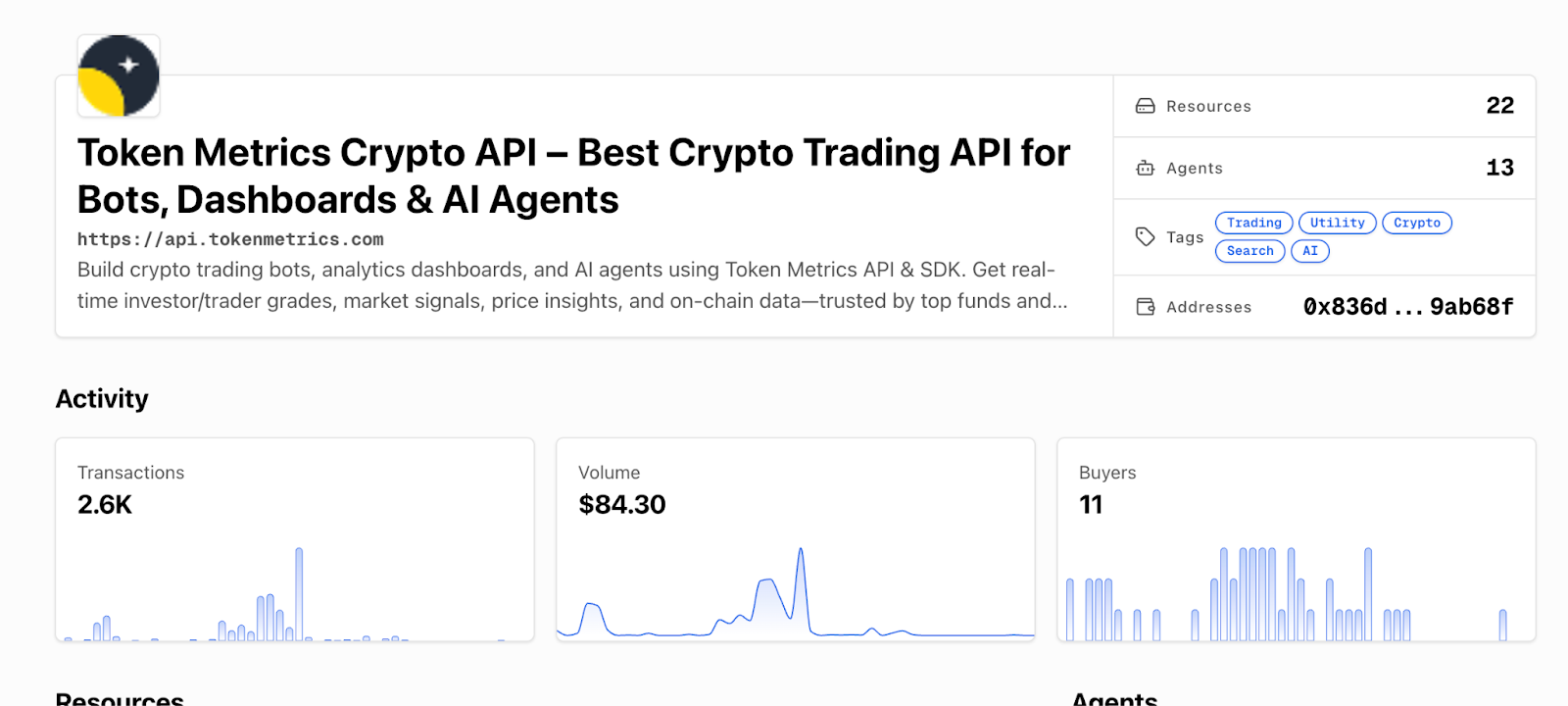
Individual agent page: Agent detail page: View tools, description, and click "Use Agent" to start.
[INSERT SCREENSHOT: Chat interface]
Chat interface: Chat UI: Ask a question like "What are the top trading signals for BTC today?"
[INSERT SCREENSHOT: Composer Feed]
Composer Feed: Live Feed: Each tool call shows the endpoint, payment token, amount, and settlement status.
That is the x402 flow in action. The agent's wallet paid for the API call automatically, the server verified payment, and the data came back. No API keys, no monthly bills, just pay-per-use access.
Key Observations from Composer
- Tool calls show the exact endpoint called (like /v2/tm-grade or /v2/moonshot-tokens)
- Payments display in USDC or TMAI with the per-call cost
- The Feed updates in real time, you can see other agents making calls across the ecosystem
- You can trace each call back to the agent and message that triggered it
- This is how agentic commerce works: agents autonomously pay for resources as needed
Part 2: Build Your Own x402 Client (Axios + HTTPX)
Now that you have seen x402 in action, let's build your own client that can call Token Metrics endpoints with automatic payment handling.
How x402 Works (Quick Refresher)
When you make a request with the x-coinbase-402 header, the Token Metrics API returns a 402 Payment Required response with payment instructions (recipient address, amount, chain). Your x402 client reads this challenge, signs a payment transaction with your wallet, submits it to the blockchain, and then retries the original request with proof of payment. The server verifies the settlement and returns the data. The x402-axios and x402 Python libraries handle this flow automatically.
Prerequisites
- A wallet with a private key (use a testnet wallet for development on Base Sepolia, or a mainnet wallet for production on Base)
- USDC or TMAI in your wallet (testnet USDC for testing, mainnet tokens for production)
- Node.js 18+ and npm (for Axios example) or Python 3.9+ (for HTTPX example)
- Basic familiarity with async/await patterns
Recommended Token Metrics Endpoints for x402
These endpoints are commonly used by agents and developers building on x402. All are pay-per-call with transparent pricing.
Full endpoint list and docs: https://developers.tokenmetrics.com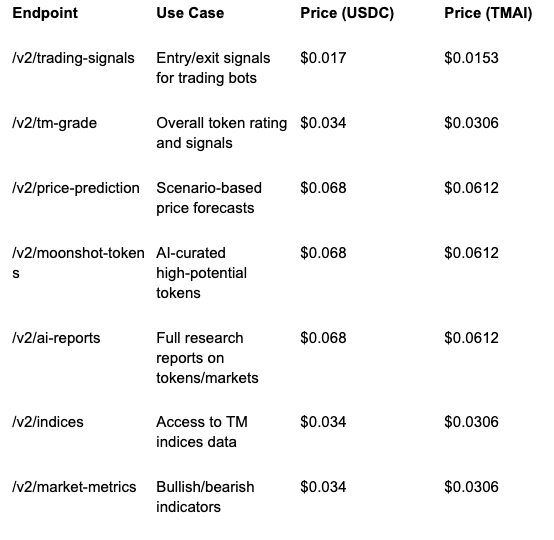
Common Errors and How to Fix Them
Here are the most common issues developers encounter with x402 and their solutions.
Error: Payment Failed (402 Still Returned After Retry)
This usually means your wallet does not have enough USDC or TMAI to cover the call, or the payment transaction failed on-chain.
- Check your wallet balance on Base (use a block explorer or your wallet app)
- Make sure you are on the correct network (Base mainnet for production, Base Sepolia for testnet)
- Verify your private key has permission to spend the token (no allowance issues for most x402 flows, but check if using a smart contract wallet)
- Try a smaller request or switch to a cheaper endpoint to test
Error: Network Timeout
x402 requests take longer than standard API calls because they include a payment transaction. If you see timeouts, increase your client timeout.
- Set timeout to at least 30 seconds (30000ms in Axios, 30.0 in HTTPX)
- Check your RPC endpoint is responsive (viem/eth-account uses public RPCs by default, which can be slow)
- Consider using a dedicated RPC provider (Alchemy, Infura, QuickNode) for faster settlement
Error: 429 Rate Limit Exceeded
Even with pay-per-call, Token Metrics enforces rate limits to prevent abuse. If you hit a 429, back off and retry.
- Implement exponential backoff (wait 1s, 2s, 4s, etc. between retries)
- Spread requests over time instead of bursting
- For high-volume use cases, contact Token Metrics to discuss rate limit increases
Error: Invalid Header or Missing x-coinbase-402
If you forget the x-coinbase-402: true header, the server will treat your request as a standard API call and may return a 401 Unauthorized if no API key is present.
- Always include x-coinbase-402: true in headers for x402 requests
- Do not send x-api-key when using x402 (the header is mutually exclusive)
- Double-check header spelling (it is x-coinbase-402, not x-402 or x-coinbase-payment)
Production Tips
- Use environment variables for private keys, never hardcode them
- Set reasonable max_payment limits to avoid overspending (especially with TMAI)
- Log payment transactions for accounting and debugging
- Monitor your wallet balance and set up alerts for low funds
- Test thoroughly on Base Sepolia testnet before going to mainnet
- Use TMAI for production to get the 10% discount on every call
- Cache responses when possible to reduce redundant paid calls
- Implement retry logic with exponential backoff for transient errors
Why This Matters for Agents
Traditional APIs force agents to carry API keys, which creates security risks and requires human intervention for key rotation and billing. With x402, agents can pay for themselves using wallet funds, making them truly autonomous. This unlocks agentic commerce where AI systems compose services on the fly, paying only for what they need without upfront subscriptions or complex auth flows.
For Token Metrics specifically, x402 means agents can pull real-time crypto intelligence (signals, grades, predictions, research) as part of their decision loops. They can chain our endpoints with other x402-enabled tools like Heurist Mesh (on-chain data), Tavily (web search), and Firecrawl (content extraction) to build sophisticated, multi-source analysis workflows. It is HTTP-native payments meeting real-world agent use cases.
FAQs
Can I use the same wallet for multiple agents?
Yes. Each agent (or client instance) can use the same wallet, but be aware of nonce management if making concurrent requests. The x402 libraries handle this automatically.
Do I need to approve token spending before using x402?
No. The x402 payment flow uses direct transfers, not approvals. Your wallet just needs sufficient balance.
Can I see my payment history?
Yes. Check x402scan (https://x402scan.com/composer/feed) for a live feed of all x402 transactions, or view your wallet's transaction history on a Base block explorer.
What if I want to use a different payment token?
Currently x402 with Token Metrics supports USDC and TMAI on Base. To request support for additional tokens, contact Token Metrics.
How do I switch from testnet to mainnet?
Change your viem chain from baseSepolia to base (in Node.js) or update your RPC URL (in Python). Make sure your wallet has mainnet USDC or TMAI.
Can I use x402 in browser-based apps?
Yes, but you will need a browser wallet extension (like MetaMask or Coinbase Wallet) and a frontend-compatible x402 library. The current x402-axios and x402-python libraries are designed for server-side or Node.js environments.
Next Steps
- Deploy your x402 client: Take the code examples above and integrate them into your app or agent
- Explore Composer: https://x402scan.com/composer
- Read the x402 docs: https://docs.cdp.coinbase.com/x402/docs/quickstart-buyers
- Check Token Metrics API docs: https://developers.tokenmetrics.com
- Join the community: Follow @tokenmetrics and @x402scan on X (Twitter) for updates and examples
Disclosure
Educational and informational purposes only. x402 involves crypto payments on public blockchains. Understand the risks, secure your private keys, and test thoroughly before production use. Token Metrics does not provide financial advice.
Quick Links
- Composer: https://x402scan.com/composer
- Composer Agents: https://x402scan.com/composer/agents
- Composer Feed: https://x402scan.com/composer/feed
- x402 Quickstart: https://docs.cdp.coinbase.com/x402/docs/quickstart-buyers
- Token Metrics API: https://developers.tokenmetrics.com
- x402 Axios (npm): https://www.npmjs.com/package/x402-axios
- x402 Python (GitHub): https://github.com/coinbase/x402-python
About Token Metrics
Token Metrics provides powerful crypto analytics, signals, and AI-driven tools to help you make smarter trading and investment decisions. Start exploring Token Metrics ratings and APIs today for data-driven success.
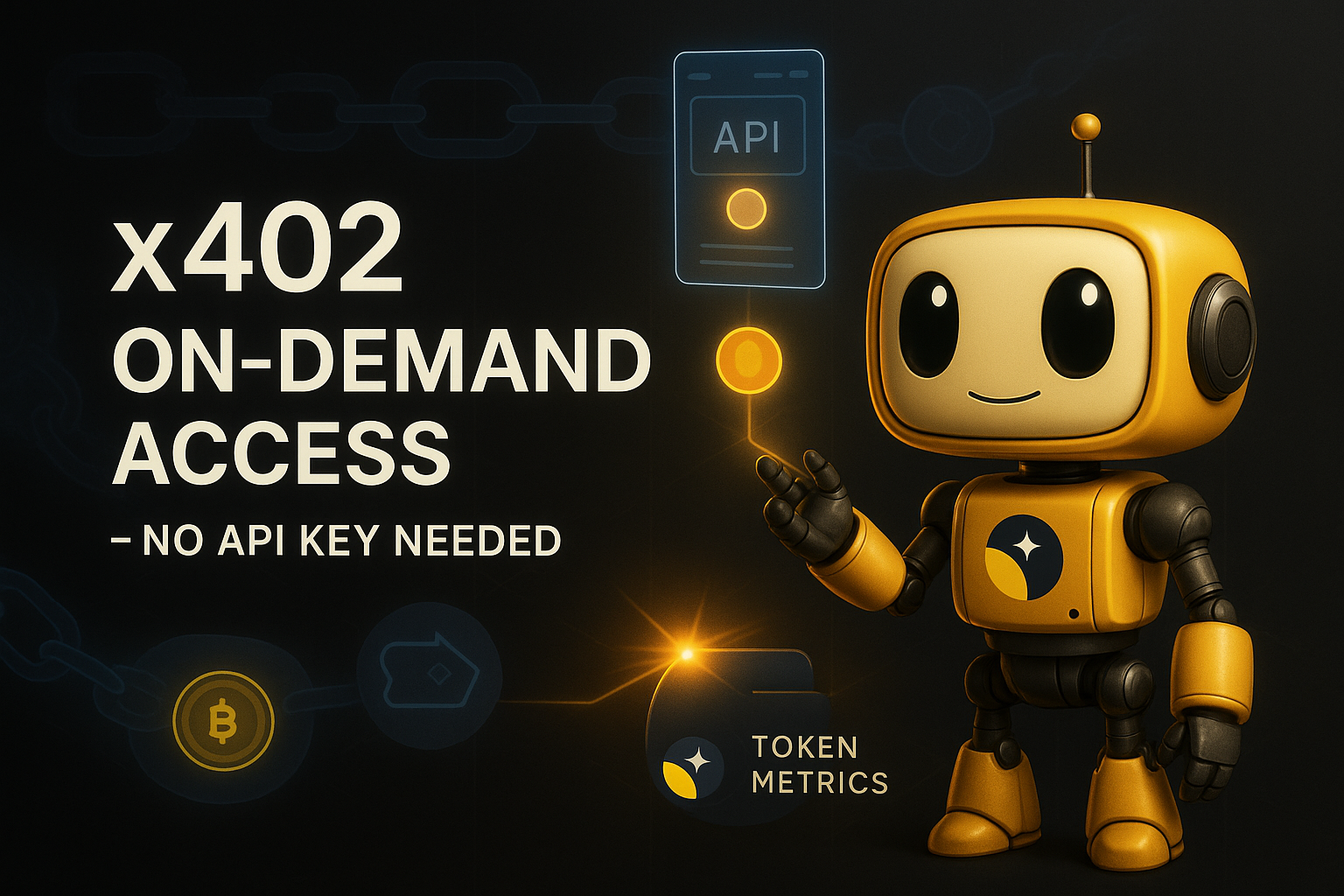
Our x402 Integration Is Live: Pay-Per-Call Access to Token Metrics—No API Key Required
%201.svg)
%201.svg)
Developers are already shipping with x402 at scale: 450,000+ weekly transactions, 700+ projects. This momentum is why our Token Metrics x402 integration matters for agents and apps that need real crypto intelligence on demand. You can now pay per API call using HTTP 402 and the x-coinbase-402 header, no API key required.
Summary: Pay per API call to Token Metrics with x402 on Base using USDC or TMAI, set x-coinbase-402: true, and get instant access to trading signals, grades, and AI reports.
Check out the x402 ecosystem on Coingecko.

What You Get
Token Metrics now supports x402, the HTTP-native payment protocol from Coinbase. Users can call any public endpoint by paying per request with a wallet, eliminating API key management and upfront subscriptions. This makes Token Metrics data instantly accessible to AI agents, researchers, and developers who want on-demand crypto intelligence.
x402 enables truly flexible access where you pay only for what you use, with transparent per-call pricing in USDC or TMAI. The integration is live now across all Token Metrics public endpoints, from trading signals to AI reports. Here's everything you need to start calling Token Metrics with x402 today.
Quick Start
Get started with x402 + Token Metrics in three steps.
- Create a wallet client: Follow the x402 Quickstart for Buyers to set up a wallet client (Node.js with viem or Python with eth-account). Link: https://docs.cdp.coinbase.com/x402/docs/quickstart-buyers
- Set required headers: Add x-coinbase-402: true to any Token Metrics request. Optionally set x-payment-token: tmai for a 10% discount (defaults to usdc). Do not send x-api-key when using x402.
- Call any endpoint: Make a request to https://api.tokenmetrics.com/v2/[endpoint] with your wallet client. Payment happens automatically via x402 settlement.
That is it. Your wallet pays per call, and you get instant access to Token Metrics data with no subscription overhead.
Required Headers

Endpoint Pricing
Transparent per-call pricing across all Token Metrics public endpoints. Pay in USDC or get 10% off with TMAI.
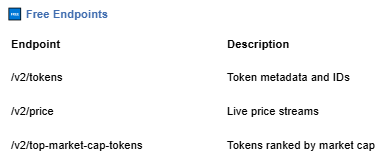



All prices are per single call. Paying with TMAI automatically applies a 10% discount.
Try It on x402 Composer
If you want to see x402 + Token Metrics in action without writing code, head to x402 Composer. Composer is x402scan's playground for AI agents that pay per tool call. You can open a Token Metrics agent, chat with it, and watch real tool calls and USDC/TMAI settlements stream into the live Feed.
Composer surfaces active agents using Token Metrics endpoints like trading signals, price predictions, and AI reports. It is a great way to explore what is possible before you build your own integration. Link: https://x402scan.com/composer
Why x402 Changes the Game
Traditional API access requires upfront subscriptions, fixed rate limits, and key management overhead. x402 flips that model by letting you pay per call with a crypto wallet, with no API keys or monthly commitments. This is especially powerful for AI agents, which need flexible, on-demand access to external data without human intervention.
For Token Metrics, x402 unlocks agentic commerce where agents can autonomously pull crypto intelligence, pay only for what they use, and compose our endpoints with other x402-enabled tools like Heurist Mesh, Tavily, and Firecrawl. It is HTTP-native payments meeting real-world agent workflows.
What is x402?
x402 is an open-source HTTP-native payment protocol developed by Coinbase. It uses the HTTP 402 status code (Payment Required) to enable pay-per-request access to APIs and services. When you make a request with the x-coinbase-402 header, the server returns a payment challenge, your wallet signs and submits payment, and the server fulfills the request once settlement is verified.
The protocol runs on Base and Solana, with USDC and TMAI as the primary payment tokens. x402 is designed for composability, agents can chain multiple paid calls across different providers in a single workflow, paying each service directly without intermediaries. Learn more at the x402 Quickstart for Buyers: https://docs.cdp.coinbase.com/x402/docs/quickstart-buyers
FAQs
Do I need an API key to use x402 with Token Metrics?
No. When you set x-coinbase-402: true, your wallet signature replaces API key authentication. Do not send x-api-key in your requests.
Can I use x402 with a free trial or test wallet?
Yes, but you will need testnet USDC or TMAI on Base Sepolia (testnet) for development. Production calls require mainnet tokens.
How do I see my payment history?
Check x402scan for transaction logs and tool call history. Your wallet will also show outgoing USDC/TMAI transactions. Visit https://www.x402scan.com.
What happens if my wallet balance is too low?
The x402 client will return a payment failure before making the API call. Top up your wallet and retry.
Can I use x402 in production apps?
Yes. x402 is live on Base mainnet. Set appropriate spend limits and handle payment errors gracefully in your code.
Next Steps
- Read the x402 Quickstart for Buyers: https://docs.cdp.coinbase.com/x402/docs/quickstart-buyers
- Explore Token Metrics agents on Composer: https://x402scan.com/composer
- Browse endpoint docs and pricing: https://app.tokenmetrics.com/en/api-plans
- Join the conversation: Follow @tokenmetrics and @x402scan on X (Twitter)
Disclosure
Educational and informational purposes only. x402 involves crypto payments on public blockchains. Understand the risks, manage your wallet security, and test thoroughly before production use. Token Metrics does not provide financial advice.
Powered by Token Metrics
Your AI-powered crypto research experience is made possible by Token Metrics. Discover data-driven insights and advanced analytics on your favorite coins and tokens.


Get Your Brand in Front of 150,000+ Crypto Investors!




 Create Your Free Account
Create Your Free Account9450 SW Gemini Dr
PMB 59348
Beaverton, Oregon 97008-7105 US
.svg)
No Credit Card Required


Online Payment


SSL Encrypted
.png)
Products
Subscribe to Newsletter
Token Metrics Media LLC is a regular publication of information, analysis, and commentary focused especially on blockchain technology and business, cryptocurrency, blockchain-based tokens, market trends, and trading strategies.
Token Metrics Media LLC does not provide individually tailored investment advice and does not take a subscriber’s or anyone’s personal circumstances into consideration when discussing investments; nor is Token Metrics Advisers LLC registered as an investment adviser or broker-dealer in any jurisdiction.
Information contained herein is not an offer or solicitation to buy, hold, or sell any security. The Token Metrics team has advised and invested in many blockchain companies. A complete list of their advisory roles and current holdings can be viewed here: https://tokenmetrics.com/disclosures.html/
Token Metrics Media LLC relies on information from various sources believed to be reliable, including clients and third parties, but cannot guarantee the accuracy and completeness of that information. Additionally, Token Metrics Media LLC does not provide tax advice, and investors are encouraged to consult with their personal tax advisors.
All investing involves risk, including the possible loss of money you invest, and past performance does not guarantee future performance. Ratings and price predictions are provided for informational and illustrative purposes, and may not reflect actual future performance.



%201.svg)


